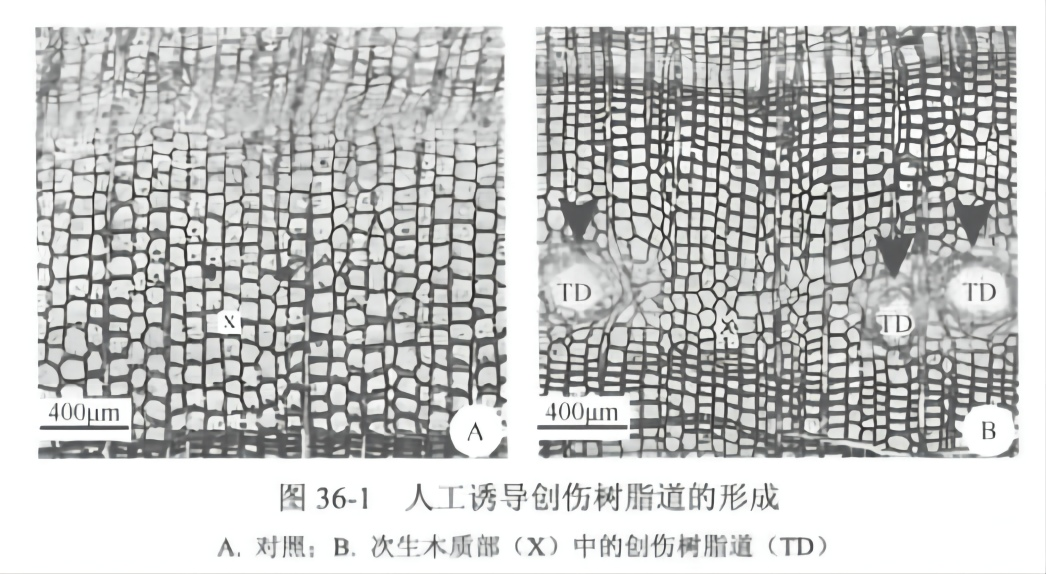Conifers are a group of gymnosperms with slender, needle-like leaves, mostly evergreen, and generally soft, some resin-containing material, consisting mainly of taxa in the Pinaceae family. Conifers are economically important forest species, they are widely distributed, have long life cycles and are an important part of the ecosystem. The Pinaceae, whose origin dates back to the Jurassic and even Triassic periods, were a very large group in geological time, with many genera, and most species of conifers have an inducible defense system, which fossil evidence suggests has existed for at least 45 million years.
The complexity of the defense system and the effective defense strategy of the conifers are the important reasons and guarantees for their longevity. During normal growth and development, conifers produce resin canals, which are called constitutive resin canals and are the main part of the constitutive defense. When conifers are subjected to mechanical damage, insect feeding, or fungal infections, they are able to induce conifers to produce traumatic resin tracts that form their induced defenses. Constitutive defense and induced defense coordinate with each other to form a strong defense system of conifers.
Operation method
Artificially induced conifer trauma Formation of resin canals
Materials and Instruments
Equipment: Move Artificially induced traumatization of conifers The basic process of resin tract formation can be divided into the following steps: (A) mechanical damage induced traumatic resin canals From April to June, two healthy whitebark pine plants were selected, one of which was traumatized at a distance of 1.5 m from the ground with a 5 mm diameter perforator, and the depth of the perforation reached the formation layer. The other plant was left untreated as a control. After 30d of treatment, samples were taken above or around the wounds, with a sample size of 3 cm × 2 cm, and the samples taken should include phloem, lamina, and xylem, and the control plant was also sampled at the same location, and the samples taken were quickly fixed in FAA fixative for 24 h and then transferred into oil softener to soften the samples for 2 weeks. (ii) Slide slicer sectioning Place the softened sample in the sample holder of the slide slicer, adjust the slice thickness of the slide slicer to 50 μm, install the slicing knife, and adjust the position of the sample so that the knife blade is close to the sample and the sample is parallel to the knife blade. Hold the sliding part of the clamping knife of the slicing knife with your right hand and pull it inward with even force, the slices will be cut off and adhered to the surface of the knife, remove the slices with a brush dipped in water into a petri dish, and then push the knife back. As the knife is pushed back, the sample holder rises to the adjusted thickness. By repeating this, many complete slices of uniform thickness can be obtained. (iii) Staining and observation of sections Move the sections carefully with a shackle to the red staining agent for 30~60 min, wash off the floating color with distilled water, place on a slide to make a fashion slide, and observe with a microscope. It can also be dehydrated and counterstained with solid green, then dehydrated, transparent and sealed to make a permanent mount. Traumatized resin tracts are often formed close to the site of the formation layer, in the newly differentiated secondary xylem, arranged in rows. Resin tracts in phloem and early-forming xylem are constitutive (Fig. 36-1).
Conifers such as whitebark pine, cedar, etc., about 10 cm in diameter.
Apparatus:
① Slide away slicer
② Microscope
Microscope ③ Knife
③ Knife ④ Shackle
⑤ Brush
⑥ Punch
⑦ Petri dish
⑧ slide
⑨ Coverslip
Reagents:
① FAA fixative
② Glycerol softener (glycerol and 95% ethanol 1:1)
③ Ethanol dehydration (50%, 70%, 85%, 95%, 100%)
③ Ethanol dehydration (50%, 70%, 85%, 95%, 100%)
⑤ Solid green stain
For more product details, please visit Aladdin Scientific website.
